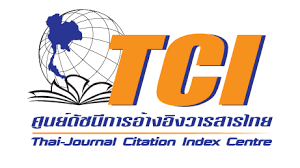การประยุกต์ใช้แป้งมันสำปะหลัง 2 สายพันธ์ุเพื่อผลิตถุงเพาะชำพลาสติกย่อยสลายได้ทางชีวภาพ
คำสำคัญ:
แป้งมันสำปะหลัง, ฟิล์มย่อยสลายได้, กลีเซอรอล, พลาสติไซเซอร์บทคัดย่อ
งานวิจัยนี้มีวัตถุประสงค์เพื่อศึกษาผลของการใช้กลีเซอรอลเป็นพลาสติไซเซอร์ต่อสมบัติทางกายภาพ และทางกลของแผ่นฟิล์มจากแป้งมันสำปะหลัง 2 สายพันธุ์ (พันธุ์ 5 นาที และ ระยอง 2) โดยฟิล์มนี้เตรียมโดยการละลายแป้งมันสำปะหลังในน้ำ ให้มีความเข้มข้นร้อยละ 5 โดยน้ำหนัก และศึกษาผลของปริมาณกลีเซอรอล 4 ระดับ คือ ร้อยละ 0, 20, 30 และ 40 โดยน้ำหนักของแป้ง ขึ้นรูปแผ่นฟิล์มโดยการทำแห้งที่ 60 องศาเซลเซียส นาน 18 ชั่วโมง นำแผ่นฟิล์มที่ได้ไปทดสอบคุณสมบัติทางกายภาพและเชิงกล ได้แก่ ความหนา ค่าแอคติวิตีของน้ำ (aw) ค่าการละลาย ค่าต้านทานการดึงขาด ค่าต้านทานแรงเจาะ และศึกษาการย่อยสลายของแผ่นฟิล์ม พบว่าความหนาของฟิล์มมีค่าระหว่าง 0.20-0.30 มิลลิเมตร สำหรับค่า aw ของแผ่นฟิล์มอยู่ระหว่าง 0.40-0.50 และพบว่าฟิล์มแป้งมันสำปะหลังทั้ง 2 สายพันธุ์ ที่ใช้กลีเซอรอลเป็นพลาสติไซเซอร์สามารถขึ้นรูปฟิล์มได้ดีและมีความยืดหยุ่น โดยมีค่าการละลายน้ำเพิ่มขึ้นเมื่อปริมาณของกลีเซอรอลเพิ่มขึ้น ค่าการต้านทานแรงดึงและค่าต้านทานแรงเจาะของฟิล์มแป้งสำปะหลังทั้ง 2 สายพันธุ์ เพิ่มขึ้นเมื่อปริมาณของกลีเซอรอลลดลง ผลทดสอบการย่อยสลายโดยการฝังในดินพบว่า ฟิล์มสามารถย่อยสลายได้ร้อยละ 55-58 ในระยะเวลา 2 สัปดาห์ โดยแผ่นฟิล์มจะย่อยสลายได้เร็วขึ้นตามปริมาณกลีเซอรอลที่เพิ่มขึ้น จากผลการทดลองแสดงให้เห็นว่าฟิล์มจากแป้งสำปะหลังทั้ง 2 สายพันธุ์ เป็นฟิล์มธรรมชาติย่อยสลายได้เองโดยธรรมชาติ ซึ่งช่วยลดปริมาณขยะย่อยสลายยากได้อีกทางหนึ่ง
References
Alves, V. D., Mali, S., Bele´ia, A. & Grossmann, M. V. E. (2007). Effect of glycerol and amylose enrichment on cassava starch film properties. Journal of Food Engineering. 78, 941-946.
Briston, J. H. (1988). Plastic Films (3rd ed.), Wiley, New York.
Chillo, S., Flores, S., Mastromatteo, M., Conte, A., Gerschenson, L. & Nobile, M. A. D. (2008). Influence of glycerol and chitosan on tapioca starch-based edible film properties. Journal of Food Engineering. 88, 159-168.
Ekthamasut, K. & Akesowan, A. (2001). Effect of vegetable oils on physical characteristics of edible konjac films. AU Journal of Technology. 5, 73-78.
Guilbert, S. (1986). Technology and application of edible film. Food packaging and preservation theory and practice. London. Elsevier Application Science Publisher.
Gontard, N., Guillbert, S & Cuq, J. L. (1993). Water and glycerol as plasticizers affect mechanical and water vapour barrier properties of an edible film. The Journal of Food Science. 55(1), 206-211.
Jiménez, A., Fabra, M. J., Talens, P. & Chiralt, Amparo. (2012). Edible and biodegradable starch films: A Review. Food and Bioprocess Technology. 5, 2058-2076.
Laohakunjit, N. & Noomhorm, A. (2004). Effect of plasticizers on mechanical and barrier properties of rice starch film. Starch/Starke. 56(8), 348-356.
Li, M. & Lee, T. C. (1996). Effect of cysteine on the functional properties and microstructure of wheat flour extrudates. Journal of Agricultural and FoodChemistry. 44, 1871-1880.
Lieberman, E. R. & Gilbert, S. G. (1973). Gas Permeationof collagen films as affected by cross-linkage, moisture, and plasticizer content. Journal of Polymer Science. 41, 33-43.
Mali, S., Sakanaka, L. S., Yamashita, F. & Grossmann, M. V. E. (2005). Water sorption and mechanical properties of cassava starch films and their relation to plasticizing effect. Carbohydrate Polymers. 60, 283-289.
Muller, C. M. O., Yamashita, F. & Laurindo, J. B. (2008). Evaluation of the effects of glycerol and sorbitol concentration and water activity on the water barrier properties of cassava starch films through a solubility approach. Carbohydrate
Polymers. 72, 82-87.
Noiduang, P. Thawla, L. & Pa-ai, O. (2015). Study on edible film production from chinese water chestnuts starch. Agricultural Science Journal. 46(3), 665-668.
Oh, J.H., Wang, B., Field, P. D. & Aglan, H. A. (2004). Characteristics of edible films made from dairy protein and zein hydrolysate cross-linked with transglutaminase. International Journal of Food Science and Technology. 39, 287-294.
Pena, D.C. & Torres, J.A. (1991). Sorbic acid and potassium sorbate permeability of an edible methylcellulose-palmitic acid films water activity and pH effects. Journal of Food Science. 56, 497-499.
Ryu, S. Y., Rhim, J. W., Roh, H. J. & Kim, S. S. (2002). Preparation and physical properties of zein-coated High-amylose corn starch film. Lebensm-Wiss. U.-Technol. 35, 680-686.
Sierakowski, M.-R., Freitas, R. A., Paula, R. C., Feitosa, J. P. A. & Rocha, S. (2004). Amylose contents, rheological properties and gelatinization kinetics of yam (Dioscorea alata) and cassava (Manihot utilissima) starches. Carbohydrate
Polymers. 55, 3-8.
Phranakhon Rajabhat Research Journal (Science and Technology) 75 Vol.14 No.2 (July - December 2019)
Tsou, C. H., Suen, M. C. , Yao, W. H., Yeh, J. T., Wu, C. S., Tsou, C. Y., Chiu, S. H., Chen, J. C., Wang, R. Y., Lin, S. M., Hung, W. S., Guzman, M. D., Hu, C. C. & Lee, K. R. (2014). Preparation and characterization of bioplastic-based
green renewable composites from tapioca with acetyl tributyl citrate as a plasticizer. Materials. 7, 5617-5632.
Veiga, S. P. (2007). Sucrose and inverted sugar as plasticizer effect on cassava starch-gelatin film mechanical properties hydrophilicity and water activity. Food Chemistry. 103, 255-262.
Downloads
เผยแพร่แล้ว
ฉบับ
บท
License
โปรดกรอกเอกสารและลงนาม "หนังสือรับรองให้ตีพิมพ์บทความในวารสารวิจัยมหาวิทยาลัยราชภัฏพระนคร สาขาวิทยาศาสตร์และเทคโนโลยี" ก่อนการตีพิมพ์



